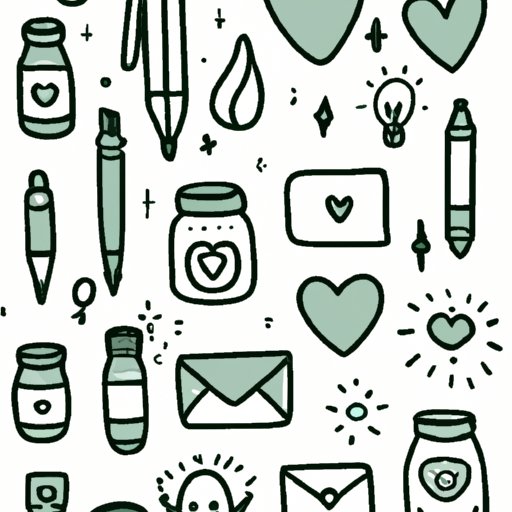I. Introduction
If you enjoy scribbling on paper or making quick sketches in your notebook, you’ve probably explored the world of doodling. Doodling is a fun and engaging form of art that can help unleash one’s creativity and imagination. This article is aimed at offering you insights on how to doodle and bringing out your potential as an artist.
Doodling is often seen as a waste of time. However, research has shown that doodling has several benefits such as improving memory, promoting focus, managing stress and anxiety, and boosting creativity. Hence, it is a healthy habit worth learning.
II. Basics of Doodling
Doodling is a spontaneous form of drawing that’s done without the pressure of producing a masterpiece. It’s a free-flowing technique where the mind can wander, often leading to unexpected and amazing artistic results.
There are different types of doodles, such as Shape-based, Pattern-based, Letter-based and Object-Based. Shape-based doodles include drawing different shapes like circles, lines or triangles mostly done randomly to create a unique design. Pattern-based doodling is where you form various designs by repeating one or two patterns. Letter-based doodles are created by filling up letters with different designs while Object-based doodles are formed by combining different objects such as leaves, flowers, or stars into a single image.
Doodling is an excellent form of self-expression and also therapeutic. It’s one way of releasing negative thoughts and getting lost in a world of color and imagination. Doodling can be a great way to reduce anxiety and stress levels. It helps to engage the brain in a repetitive motion, allowing it to calm down and reducing cortisol levels, a hormone that causes stress.
III. Creative Techniques for Doodling
Doodling is not limited to just simple designs. You can add depth to your doodles by incorporating shading, color, and texture. These techniques can add character and realism to traditional doodles and bring them to life. Try experimenting with different techniques and see what works best for you. You can also create a unique style by adding your own twists to traditional techniques.
Shading is the use of tonal variations to create the illusion of form and can add depth to your doodles. You can use dots, hatching, or cross-hatching techniques to create different shades. Using color in your doodle can add vibrancy and bring out the design. You can try using different color schemes or blend colors to create new shades. Texture can also add depth and dimension to your doodles. You can use lines, dots, or other simple strokes to create textures, such as the texture of fur on animals, or the texture of leaves.
IV. Step-by-Step Tutorials
If you’re new to doodling and want to get started, here are some easy-to-follow tutorials:
1. Basic Shapes – Draw different shapes such as circles, squares, triangles, and rectangles, and fill them with different designs.
2. Letter Doodles – Write your name or any word with bubble letters and fill it with different patterns and designs.
3. Zentangle – A combination of doodling and meditation. You can create different patterns using structured and repetitive strokes.
4. Mandala – A complex and symmetrical design that’s often circular in form. It’s a great way to practice concentration and patience.
V. Inspiration for Doodling
Gather inspiration from popular social media influencers like @mariekbloch, @banguela_art, or famous artists like Vincent van Gogh, or Pablo Picasso. You can find images of artists’ works on platforms like Pinterest or Instagram. These artists have created unique styles and approaches that you can draw inspiration from. However, remember to find your own style and be authentic.
VI. Best Tools for Doodling
The best tools for doodling include pens, colored pencils, and digital tablets. Pens are great for fine lines and details. Ballpoint pens can provide a variety of line weights and textures. Colored pencils have a broader range of colors and can create a variety of textures. Digital tablets such as Wacom enable digital artists to doodle and create art that can be easily shared online or even printed. Choosing the right tools is essential in achieving the desired results.
VII. Cool Ideas for Where to Doodle
Doodling can be done anywhere and anytime. It can be a meditative practice and help you relax or even brainstorm new ideas. You can doodle at your workplace during a long meeting or during your daily commute. You can doodle in a park, a cafe, or even at home. The possibilities are endless. All you need is your favorite tool and your imagination.
VIII. Conclusion
Doodling is an excellent way to express yourself creatively, and it has several benefits as well. It’s a perfect way to release negative thoughts and emotions, reduce anxiety and stress, and improve memory and focus. It’s also a great way to practice mindfulness and relaxation. Don’t be afraid to experiment with different techniques and find your own unique style. Doodle your way to a happier and more creative you.
“Art is not what you see, but what you make others see.” — Edgar Degas.
